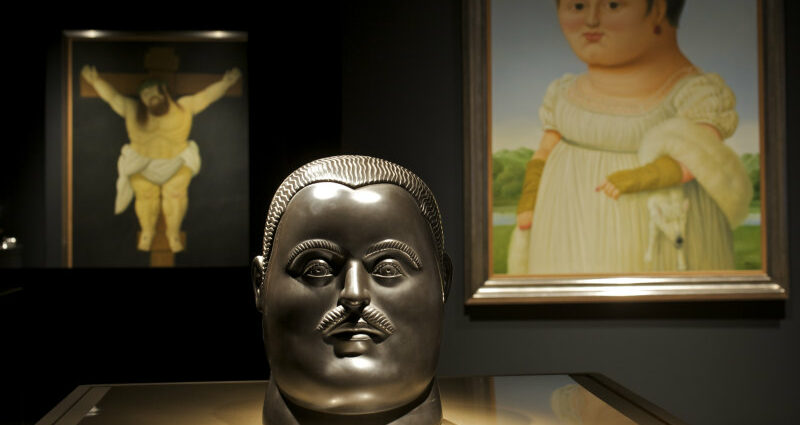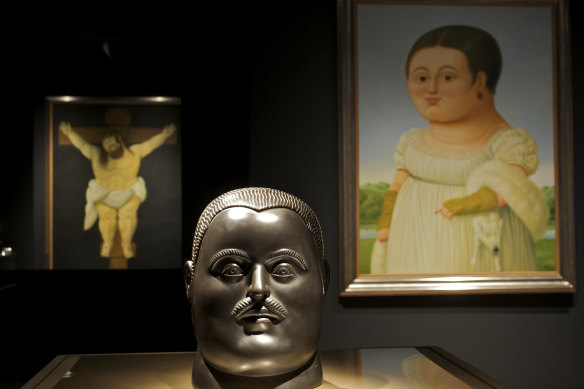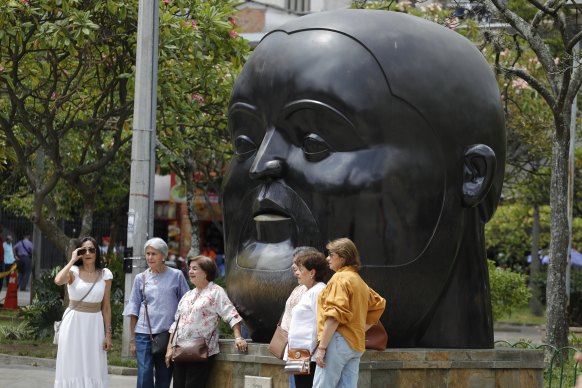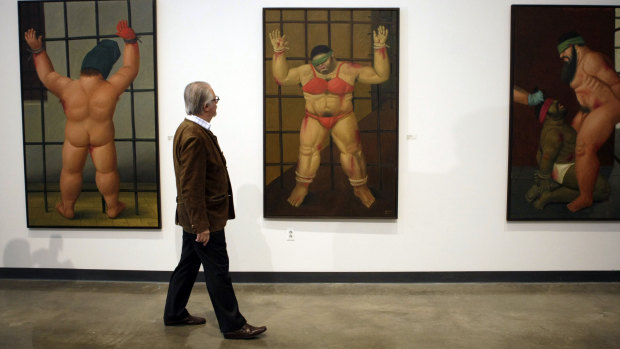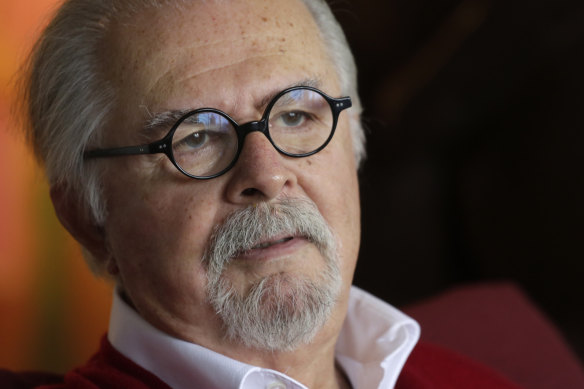Save articles for later
Add articles to your saved list and come back to them any time.
Bogota: Colombian artist Fernando Botero, whose sculptures and paintings of playful, rotund subjects in sometimes harrowing situations made him one of the world’s richest artists, died on September 15 at age 91.
Heralded as South America’s answer to Picasso, Botero also tackled violence and political topics, including Colombia’s internal conflicts, as well as portraying daily life.
Columbian artist Fernando Botero’s artwork is showcased at the Bowers Museum.Credit: AP
His works have featured in exhibitions across the world. His canvases and sculptures sell for more than $2 million each, according to Sotheby’s.
The artist’s bodacious subjects were portrayed in everyday situations – a corpulent naked woman lounging on a bed or a stout man riding a humorously out-sized horse – but served the artist’s more serious goal of transporting the reader to what he called a “superlative dimension”, where commonplace situations took on exaggerated proportions.
A sculpture by Fernando Botero at Botero Park in Medellin, Colombia.Credit: AP
Despite the comic plumpness of many of his creations, the artist never shied away from serious subject matter – his series of paintings about the Abu Ghraib prison scandal generated discussion across the art world.
“Fernando Botero has died, the painter of our traditions and defects, the painter of our virtues. The painter of our violence and of peace,” Colombian President Gustavo Petro said on X, the social network formerly known as Twitter.
Colombian artist Fernando Botero looks over his paintings and drawings on Abu Ghraib prison at American University Museum in Washington in 2007. Botero died on September 15, age 91.Credit: AP
Although widely known for his large subjects, Botero insisted his pieces were not focused on body type.
“I don’t paint fat women,” the artist told Spain’s El Mundo newspaper in 2014. “No one believes me, but it’s true. What I do paint are volumes.”
Botero’s work sometimes focused on Colombia’s long-running internal conflict – he painted the aftermath of a car bomb and a group of party-goers menaced by men wielding automatic weapons and bloody machetes.
He also created tongue-in-cheek portraits of public figures, including Revolutionary Armed Forces of Colombia (FARC) rebel group founder Manuel Marulanda.
Fernando Botero during an interview in New York in 2013.Credit: AP
Botero also paid tribute to classic paintings with witty rehashings – his version of the Mona Lisa is notably bloated compared to Da Vinci’s original.
But it was his Abu Ghraib series which commanded global attention. The paintings, based on victim accounts and photos taken of the abuse of Iraqi prisoners by US soldiers, are explicit and harrowing.
The series was exhibited around the world, drawing tens of thousands of viewers. The New York Times said the paintings, while not masterpieces, “restore the prisoners’ dignity and humanity without diminishing their agony.”
Botero’s final decades as one of the world’s wealthiest artists were a far cry from his humble beginnings.
Fernando Botero Angulo, the son of a travelling salesman and a seamstress, was born on April 19, 1932 in Medellin, Colombia.
As an artist, Botero sought to make his work accessible, donating over 200 works to create the Botero Museum in Bogota, which is free and receives half a million visitors a year.
More than a hundred of the pieces were his own, while others were by masters including Picasso, Dali and Monet.
He gave another 150 works to a Medellin museum, and 23 of his sculptures are installed outside in the Plaza Botero.
Botero is survived by his wife Sophia Vari, two sons and a daughter. Another son, aged 4, was killed in a car crash in 1974.
Even into his 80s, the artist painted for a minimum of eight hours a day.
“I want to die painting,” he told Colombia’s El Tiempo newspaper the year he turned 80.
Reuters
Start the day with a summary of the day’s most important and interesting stories, analysis and insights. Sign up for our Morning Edition newsletter.
Most Viewed in World
From our partners
Source: Read Full Article
-
UK’s spookiest location is haunted by ‘black-eyed’ girl lurking in woods
-
Wild life of con artist who flaunted private jets, Chanel clothes and holidays
-
Rep. Lauren Boebert escorted out of “Beetlejuice” musical in Denver
-
Interpol investigating 21 mystery deaths after 'Woman with Flower Tattoo' case – as cops probe sinister connection | The Sun
-
Three grizzlies infected with contagious BIRD FLU are euthanized
